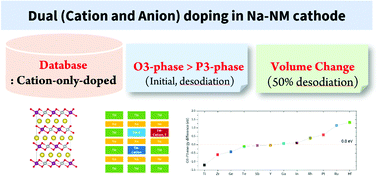Dual doping with cations and anions for enhancing the structural stability of the sodium-ion layered cathode†
Abstract
First-principles-based calculations were implemented to explore the ideal combination of cations and anions as dual dopants for enhancing the structural stability of the sodium-ion layered cathode for application in sodium ion batteries (SIBs), leading to improved electrochemical properties. Cation-doped NaNi0.42Mn0.5D0.08O2 was chosen as the reference structure, where D represents twelve cation dopants (Ga, Ge, Hf, In, Pt, Rh, Ru, Sb, Te, Ti, Y, and Zr), which have been proven to have excellent performance. Fluoride was selected as the anion dopant to give the general formula NaNi0.42Mn0.5D0.08O1.96F0.04, leading to a total of twelve different combinations of cation and anion co-doped structures. The screening criteria include the formation energy, which was used to confirm the thermodynamically favored locations of the dopants; the phase stability; and the volume change accompanying the transformation from the O3- to P3-phase after 50% desodiation. The calculations show that Te–, Sb–, Hf–, Y–, and Ti–F are the five most effective dual dopants for potentially enhancing the structural stability of the sodium-ion layered oxide during cycling. The present study provides an essential design map for developing an ideal dual doping strategy for SIBs.



 Please wait while we load your content...
Please wait while we load your content...